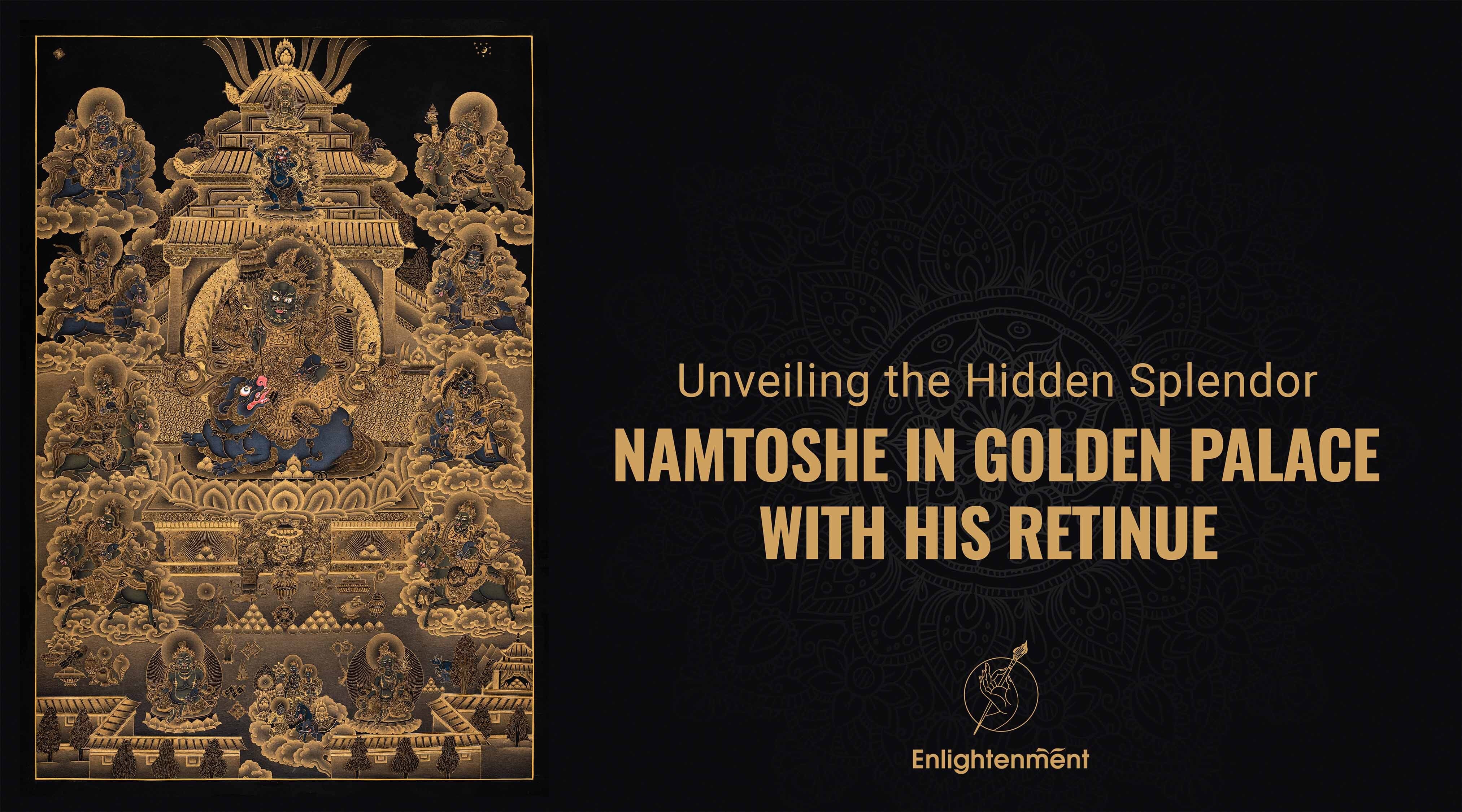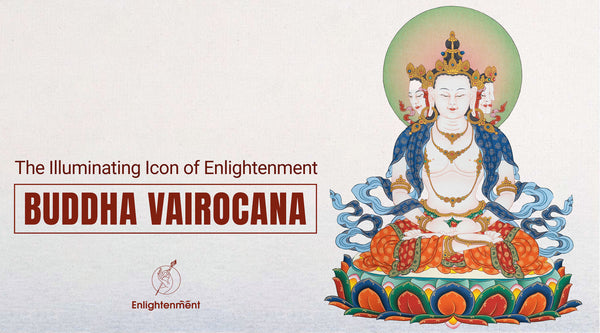Unvelling The Hidden Splendor of Heavenly King Vaisravana's Palace- Alakapuri
Vaiśravaṇa, also known as the 'one who hears everything,' holds a prominent position among the Four Heavenly Kings and serves as the primary guardian of the North cardinal direction and ruler of the Yakshas, a class of supernatural beings. In Chinese, he is referred to as "Duo Wen", while in Sanskrit, he is known as Vaiśravaṇa. He is often depicted in his magnificent golden palace, Alakapuri. This further adds to his symbolism of opulence and divine authority.
This celestial figure is sometimes likened to Bodhisattva Kuan Yin and goes by various names, including Kubera, Namtose (Namthose), Vessavana, Thao Kuwen, Wetsawan, Wetsuwan, and Wéthawún Nat Min. He wields authority over water and rain, symbolizing wealth and influence.
Hindu Mythology's Roots
Vaisravana was a significant figure in Hindu mythology before rising to prominence in Buddhism. He was referred to as Kubera in this region and was the wealthy lord and protector of the North. His shift into Buddhist mythology is an intriguing examination of the syncretism seen in ancient Asian cultures.
Transition Into The Lore Of Buddhism
Vaisravana discovered a new home in the expansive pantheon of deities of Buddhism as it flourished and spread throughout Asia. As his function developed, he came to represent wealth and a figure of protection, preserving the Buddha's teachings and assisting the devout on their spiritual path.
He is the supreme protector of the northern direction in Buddhist cosmology. He has a crucial function in promoting spiritual development and providing defense against evil powers. His guardianship is evidence of his fortitude and goodness, highly regarded by his followers.
Vaishravana Guardian King Of The North's Depiction
Click here to view our Vaisravana Canvas Art Print
Vaiśravaṇa is often associated with yellow and green and is represented by emblematic symbols like the umbrella, stupa, pagoda, and mongoose. As the guardian of material wealth and spiritual prosperity, he imparts the importance of careful handling and generosity. By invoking Vaiśravaṇa's attributes, practitioners strive to cultivate a balanced approach to worldly matters while remaining rooted in spiritual principles.
He frequently dons an elaborate crown with skulls or precious jewels/ gemstones. He might be decked out in ornate clothing with anklets, bracelets, and other jewelry pieces.
The deity has a fire or burning mandala surrounding him, representing his powerful and transformational spirit. The flames represent the eradication of unhelpful emotions and the birth of wisdom. He may be seen with attendant deities, guardians, or vengeful beings.
These entities emphasize his function as a watcher over and defender of practitioners. The chatra/ parasol would emphasize his function as a protector deity who guards believers against danger and challenges on their spiritual journey. It protects the mind from contamination, ensuring its purity and clarity.
The artwork in and around Vaisravana is not just a visual delight; it also tells a symbolic story. Every detail, including his elaborate jewelry and the beautiful designs on his robes, tells a tale and reflects his character strengths of compassion, moral courage, and spiritual care.
The Golden Palace of The Heavenly King

Vaisravana's Golden Palace, which outshines even the most precious gemstones, is in its heavenly abode. The cosmic mountain at the center of the Buddhist and Hindu universes, Mount Sumeru, is believed to contain the palace on its northern slope. With its elaborate decorations, expansive courtyards, and towering spires that rise toward the heavens, the palace is an architectural masterpiece in and of itself.
Gold and priceless gemstones decorate the palace's facade, signifying the prosperity and abundance connected with the deity. According to legend, the walls were constructed from lapis lazuli, which shone with a deep blue color that elegantly contrasted with the roof's radiant gold color. The palace is surrounded by rich gardens with heavenly flowers, exotic trees, and free-roaming ethereal beings.
Architectural Marvels
- The Golden Facade: A Symbol of Prosperity
The palace's gilded façade, which stands as a tribute to its opulence and success, is seen as one approaches it. The rich decorations and detailed sculptures tell tales of a time when spirituality and worldly wealth coexisted in perfect harmony.
- Interior Splendors: A Glimpse into the Palace's Grandeur
When one enters, a kaleidoscope of hues and patterns greets them. The interiors, a taste of the luxurious lifestyle that once flourished behind these golden walls, are a beautiful fusion of art and faith.
- A Verdant Paradise: Flora and Fauna
The gardens of Alakapuri are a lush oasis for the plants and animals that flourish in this heavenly city. For seekers, the beautiful surroundings provide a haven to meditate and connect with nature.
- The Serene Lotus Ponds: A Place for Meditation
The calm lotus ponds are tucked away within the gardens and are a haven of peace and tranquility. These lotus-adorned ponds provide a place for meditation and reflection so people can connect with their inner selves.
- The Extensive Fresco and Mural Tapestry
A beautiful tapestry of murals and frescoes that each tell stories about Buddhist philosophy and the life of Vaisravana grace the palace's walls. These works of art offer insights into the profound teachings at the core of this ancient religion and act as a visual journey through the history of Buddhism.
Spiritual Significance Of The Golden Palace
- The Residence of Money and Prosperity
The Golden Palace is more than just a building; it is a living thing that personifies the values of abundance and success. It serves as a reminder that monetary prosperity and spiritual enlightenment may coexist, promoting a culture that benefits from mutually beneficial interaction.
- Spirituality and Material Wealth in Context
The Golden Palace, which offers a route that leads to personal enrichment and spiritual progress, is a light of hope at the intersection of spirituality and worldly wealth. It encourages people to strive for a life that is abundant in both material and spiritual elements, promoting peace of mind.
Vaisravana resides in the palace on a magnificent throne made of gold and covered in precious stones. It reminds him of the ideals of protection, generosity, and wealth he represents among the civilizations that revere him. The palace serves as a symbol of inspiration for a life of prosperity and spiritual enlightenment in the hearts and minds of his devotees.
The Defender of the Dharma
Vaisravana embodies righteousness and morality in his capacity as the guardian of Dharma. His teachings encourage followers to follow the path of virtue, promoting a just and compassionate society. His teachings act as a beacon, pointing people toward a life filled with spiritual fulfillment.
Buddhist doctrine emphasizes the significance of treating wealth ethically. Alakapuri's message resonates with deeds of generosity, compassion, and just resource management.
Both the physical and metaphysical come together in Alakapuri, a place that shines as a beacon of spiritual awakening. This realm exists outside of time and provides a window into the richness of spiritual treasure and the vast depths of Buddhist teachings.



